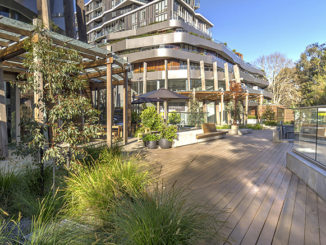Climate change is increasingly the largest issue facing the world with report after report raising the alarm bells. But these warnings appear to be falling on deaf ears of many nations and states, with governments who seek to maintain short term economic growth rather than invest in the long term. It is now falling to local governments, non-profit
Recent predictions
The Intergovernmental Panel on Climate Change (IPCC) report published in late 2018 was one of the most alarming reports in recent times, predicting that we are truly running out of time to limit the increase of temperature to 1.5 degrees centigrade by 2030.
A panel at the past ASLA conference included Collen Mercer Clarke, chair of the Canadian Society of Landscape Architects(CSLA) and Chair, IFLA Working Group on Climate Change, Vaughn Rinner, FASLA, famed designer Martha Schwartz and Pamela Conrad. They emphasized the importance of recent analysis, in books such as “Drawdown” by Paul Hawken that show the metrics for reducing the impacts of climate change. These could be used as tools to help us change the way we live, work and design. The panel also called on landscape architecture organisations to create a 2030 landscape architecture challenge similar to the Architecture 2030 challenge.
A call to action
For the past 30 years, we have known about climate change and global warming. In the past decade it has been increasingly on the front page of newspapers and at the top of social media feeds, but it seems that we haven’t made enough solid progress on reducing our environmental impacts and mitigating the impact of climate change. We need to shift from constantly raising the problems and move forward with a solutions-based agenda. We need to make people aware of the many benefits of shifting to a greener economy. There so many benefits from taking action against climate change, including cleaner cities, better health, new job creation, energy efficiency and more.
Positive approach
What we have to remember is that whilst there is no silver bullet for current climate change, there are many more than just one approach to solving the problems. Cities, as centres of population, economic growth and innovation need to take more action and seek to test different approaches that could best suit the local climatic conditions and cultural nuances.
As landscape architects how do we move forward to reduce the impact of climate change? We need to take action to realise both short and long-term outcomes, across multiple fields; land-use, conservation, technology, urban design, horticulture, communication and education amongst others, including as some examples, the following:
- advocate and work towards sustainable land use and land planning
- advocate for conservation and sustainable agriculture
- increase urban densification balanced with heat island mitigations
- design for efficient transportation (multi-modal, public, shared and private)
- advocate and design green infrastructure systems for cities
- design for social inclusivity and public health
- use best practice design & construction standards (SITES, LEED, WSUD, SuDS, SIDS, etc)
- use of design technologies (such as BIM) to better coordinate systems and reduce waste.
- Increase the selection of sustainable materials
- seek out suppliers with sustainable products or push existing suppliers to provide sustainable alternatives
- install sustainable energy systems with storage where possible (roofs, poles, etc)
- install water mitigation and storage systems to reduce flood events, offset irrigation, and recharge water systems.
- specify efficient irrigation
- select efficient lighting fittings connected to an off-grid energy storage
- advocate for ecosystem restoration and reforestation
- select plants for adaptation to the change in climate
- increase biodiversity through planting design
- pick office locations close to public transport/multimodal transport
- educate your workplace about design approaches to reduce climate change
- educate allied professions on the benefits of the landscape (urban forest, heat island reduction, water attenuation, etc)
- work with your local and global landscape organisations to increase awareness within the industry and lobby governments
- fund or mentor research by landscape schools into climate change solutions or tools.
The above is not an exhaustive list however it provides ideas and actions that we can all undertake as landscape architects. However, there are many places around the world where climate change is an issue and where landscape architecture is a new profession. The key is that we share of knowledge and experience through publication and education. It is also beneficial to translate documents into other languages so there is sharing of the knowledge and solutions. We can also help financially be donating to organisations in developing nations to improve access to education, information and technology.
The next steps
It is time for action at local, regional, national and global levels, there has been a great amount written and presented about climate change especially in the past decade but with 2030 looming in just over a decade we need to take action. We need to make a difference not just creating exemplar (case study) projects but wherever we can in each project for incremental and whenever possible we need to advocate for a dramatic change to ensure that we and future generations can continue to live on this one earth that we call home.
Tools for making a difference
- Summary for Policy Makers (IPCC)
- SITES – Rating System and Scorecard (English, Spanish, Chinese)
- ASLA Resource Guides
- Carbon and Landscapes
- The Carbon Landscape
- Sustainable Landscape Rating Tool
If you wish to contribute to this conversation head over to the WLA Linkedin page or facebook page. Or email your response to damian@worldlandscapearchitect.com
Article Written by Damian Holmes is the Founder and Editor of WLA.
He is also a registered Landscape Architect with extensive experience in Australia, Canada, and China.
Cover Graphic : Flickr user – NASA Goddard Space Flight Center



